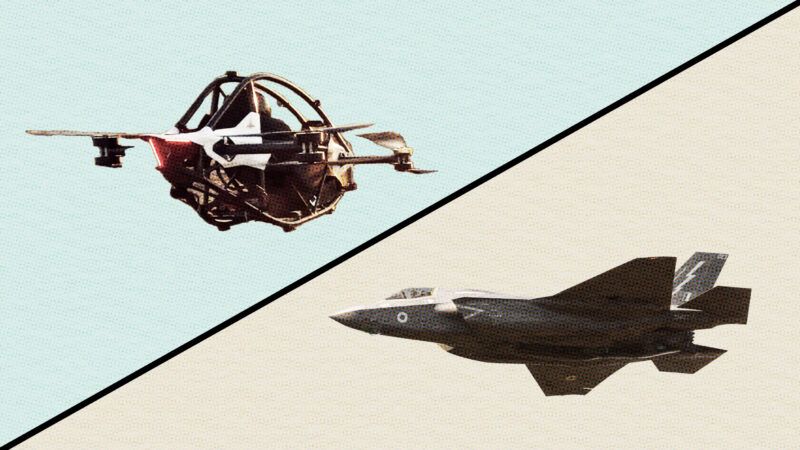Will We Get Private Flying Cars Before the Pentagon Manages To Get This New Jet Off the Ground?
A Swedish company will soon be delivering electric single-person aircraft that can take off and land vertically, which the F-35B struggles with despite billions in funding.

People have anticipated the invention of flying cars for nearly as long as there have been regular cars on the road. Last week, central Virginia's Chesterfield Observer reported on an unexpected problem in Richmond: Flying cars are finally here, whether aviation authorities like it or not.
An adviser to a nearby airport warned the local planning commission that a Charlottesville resident had ordered, and would soon be taking possession of, the appropriately named Jetson One, a $92,000 personal aircraft designed and sold by Swedish company Jetson Aerospace. The Jetson One is an eVTOL—an electric vertical takeoff and landing aircraft. It operates more like a helicopter than an airplane, able to hover in place and raise and lower its altitude.
Despite the news coverage's framing, flying cars are not imminently arriving in your neighbor's driveway. But it's worth comparing the progress of private companies like Jetson to the billions spent by the Pentagon, and how well each is doing at delivering on a technology that can take off and land vertically.
First things first: The Jetson One is not a flying car, despite what the name might suggest. The company may co-opt The Jetsons for its branding, but the days of a family sedan that can motor around without touching pavement are still a thing of fantasy.
In reality, it's better described as a drone with a seat, resembling a dune buggy with propellers instead of wheels. It can reach top speeds over 60 mph and a cruising altitude of more than 1,500 feet in the air. It's all-electric and a single charge provides around 20 minutes of flight time. The company promotes it as "a formula one racing car for the sky" and boasts that the controls are easy to learn and it can be flown without a pilot's license.
But eVTOLs are a burgeoning market. At this year's Consumer Electronics Show, California-based company Aska debuted the A5, a four-passenger craft the size of an SUV. It hopes to be able to achieve 70 mph on roads and 150 mph in the air, and it will retail for $789,000.
Meanwhile, the Pentagon has spent billions of dollars developing a VTOL of its own, with rather different results. The F-35 fighter jet program is a notorious boondoggle, which will cost taxpayers an estimated $1.7 trillion over the program's lifetime. Of the jet's three different designs, the F-35B is designed for vertical takeoffs and landings so that it can operate from smaller runways.
Last month, an anchor from Dallas/Fort Worth's CBS affiliate tweeted a video of an F-35B landing at a local naval air base. The jet spends a few seconds gingerly floating down to the ground, but instead of staying in place it bounces on its landing gear and the nose dips straight down. When it hits the ground again nose-first, the front wheel snaps off, and the plane spins in circles on the ground before the pilot ejects.
#Breaking New much clearer video, courtesy Kitt Wilder, of STOL variant F35 B model landing JRB Fort Worth, and pilot ejects. Condition of pilot still unknown. @CBSDFW pic.twitter.com/BeERIeyhtO
— Doug Dunbar (@cbs11doug) December 15, 2022
As Kelsey Atherton noted at Jalopnik, this was the third F-35 to crash in 2022, with each plane costing $100 million. The F-35B is supposed to represent the newest and best of America's war-making technology. (Of course, no other country spends anything close to what the U.S. does on defense, and it's far from clear that the extra money translates into greater security.) Instead, the Government Accountability Office calls the F-35 program a "material weakness" in the Pentagon's arsenal.
Granted, comparing the F-35 to the Jetson One is apples-and-oranges: The F-35B is intended to operate under high-pressure situations, over longer distances, while loaded down with heavy weaponry. But it's worth noting that while the Pentagon continues throwing untold billions at the F-35, Jetson Aerospace brought the Jetson One to market with $10 million in seed money. Meanwhile, when taxpayers are footing the bill for a plane, even takeoffs and landings can be too much to ask.


Show Comments (61)